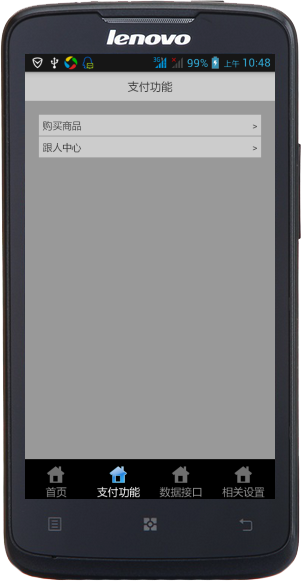先上效果图 
此图就是我所实现的底部菜单栏
xml布局如下:
<!-- lang: xml -->
<TabHost xmlns:android="http://schemas.android.com/apk/res/android"
xmlns:tools="http://schemas.android.com/tools"
android:id="@android:id/tabhost"
android:layout_width="match_parent"
android:layout_height="match_parent" >
<LinearLayout
android:orientation="vertical"
android:layout_width="fill_parent"
android:layout_height="fill_parent">
<FrameLayout
android:id="@android:id/tabcontent"
android:layout_width="fill_parent"
android:layout_height="0.0dip"
android:layout_weight="1.0" />
<TabWidget
android:id="@android:id/tabs"
android:visibility="gone"
android:layout_width="fill_parent"
android:layout_height="wrap_content"
android:layout_weight="0.0" />
<RadioGroup
android:gravity="center_vertical"
android:layout_gravity="bottom"
android:orientation="horizontal"
android:id="@+id/main_radio"
android:background="#000000"
android:layout_width="fill_parent"
android:layout_height="wrap_content">
<RadioButton
android:id="@+id/radio_button0"
android:tag="radio_button0"
android:layout_marginTop="2.0dip"
android:text="@string/main_home"
style="@style/main_tab_bottom" />
<RadioButton
android:id="@+id/radio_button1"
android:tag="radio_button1"
android:layout_marginTop="2.0dip"
android:text="@string/main_pay"
style="@style/main_tab_bottom" />
<RadioButton
android:id="@+id/radio_button2"
android:tag="radio_button2"
android:layout_marginTop="2.0dip"
android:text="@string/main_data_interface"
style="@style/main_tab_bottom" />
<RadioButton
android:id="@+id/radio_button3"
android:tag="radio_button3"
android:layout_marginTop="2.0dip"
android:text="@string/main_setting"
style="@style/main_tab_bottom" />
</RadioGroup>
</LinearLayout>
</TabHost>
从布局可以看出,虽然使用了tabhost,但实际实现图上菜单效果的是radiogroup和radiobutton,在布局上将TabWidget 控件隐藏,显示时用radiobutton来代替,这样也容易自定义一些效果。
radiobutton的样式:
<!-- lang: xml -->
<style name="main_tab_bottom">
<item name="android:textSize">@dimen/bottom_tab_font_size</item>
<item name="android:textColor">@drawable/main_menu_text_selector</item>
<item name="android:ellipsize">marquee</item>
<item name="android:gravity">center_horizontal</item>
<item name="android:background">@null</item>
<item name="android:paddingTop">@dimen/bottom_tab_padding_up</item>
<item name="android:layout_width">fill_parent</item>
<item name="android:layout_height">wrap_content</item>
<item name="android:button">@null</item>
<item name="android:drawableTop">@drawable/main_menu_background_selector</item>
<item name="android:singleLine">true</item>
<item name="android:drawablePadding">@dimen/bottom_tab_padding_drawable</item>
<item name="android:layout_weight">1.0</item>
</style>
图上点击选项卡的效果就是通过样式中的android:textColor和android:drawableTop来改变的。 就是通过selector来控制,需注意,在此处所应用的场景中,所选状态的改变应该通过checked属性来控制,而不是focused和pressed。如下:
<!-- lang: xml -->
<?xml version="1.0" encoding="utf-8"?>
<selector xmlns:android="http://schemas.android.com/apk/res/android" >
<item android:drawable="@drawable/home_selected" android:state_checked="true"/>
<item android:drawable="@drawable/home_normal"></item>
</selector>
activity代码:
<!-- lang: java -->
public class MainActivity extends TabActivity implements OnCheckedChangeListener {
private TabHost tabHost;
private RadioGroup radioGroup;
@Override
protected void onCreate(Bundle savedInstanceState) {
super.onCreate(savedInstanceState);
requestWindowFeature(Window.FEATURE_NO_TITLE);
setContentView(R.layout.activity_main);
radioGroup = (RadioGroup)findViewById(R.id.main_radio);
tabHost = getTabHost();
tabHost.addTab(addTabSpec("1", "1", new Intent(this, HomeActivity.class)));
tabHost.addTab(addTabSpec("2", "2", new Intent(this, PayActivity.class)));
tabHost.addTab(addTabSpec("3", "3", new Intent(this, DataInterfaceActivity.class)));
tabHost.addTab(addTabSpec("4", "4", new Intent(this, SettingActivity.class)));
radioGroup.setOnCheckedChangeListener(this);
}
private TabHost.TabSpec addTabSpec(String tag,String label,Intent intent){
return tabHost.newTabSpec(tag).setIndicator(label).setContent(intent);
}
@Override
public void onCheckedChanged(RadioGroup arg0, int checkedId) {
switch (checkedId) {
case R.id.radio_button0:
tabHost.setCurrentTabByTag("1");
break;
case R.id.radio_button1:
tabHost.setCurrentTabByTag("2");
break;
case R.id.radio_button2:
tabHost.setCurrentTabByTag("3");
break;
case R.id.radio_button3:
tabHost.setCurrentTabByTag("4");
break;
}
}
}
代码编写上,仍然通过tabhost来切换不同的页面。






















 139
139

 被折叠的 条评论
为什么被折叠?
被折叠的 条评论
为什么被折叠?








